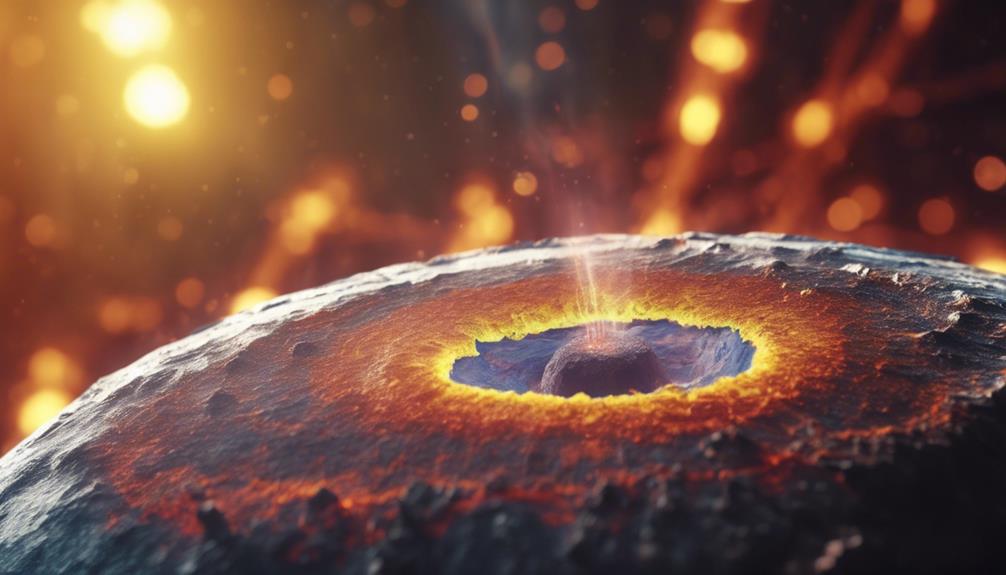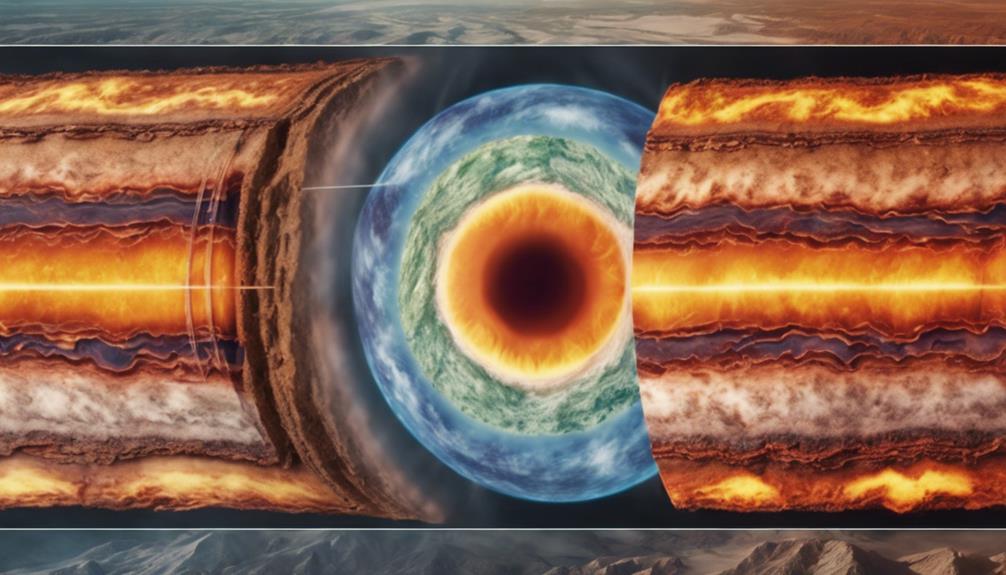Earth's inner heat comes from radioactive decay of elements like uranium and thorium in the Earth's crust. This process releases heat energy, shaping Earth's thermal structure and providing sustainable heat sources for electricity generation and heating. The geothermal energy harnessed from this heat offers insights into renewable power and helps in understanding Earth's thermal dynamics. Discover more about how this natural process powers our planet and influences climate patterns.
Key Takeaways
- Earth's inner heat comes from radioactive decay of elements like uranium and thorium.
- Geothermal energy harnesses heat from underground reservoirs for electricity.
- Radioactive decay in Earth's crust and core contributes to geothermal energy sources.
- Earth's core temperature of 4,000°C drives geothermal energy production.
- Geothermal energy is a sustainable power source utilizing Earth's natural heat.
Earth's Heat Generation
Delving into Earth's heat generation reveals a fascinating interplay of natural forces shaping our planet's core temperatures. At 25 kilometers beneath the surface, Earth's heat spikes to 750°C, surging to a blazing 4,000°C at the core.
This immense heat emanating from within the Earth, totaling a staggering 47 terawatts, primarily stems from the phenomenon of radioactivity. Radioactive elements like uranium, thorium, and potassium within the Earth's crust undergo decay processes, releasing energy in the form of heat.
Geothermal technology capitalizes on this abundant heat source, offering a sustainable and renewable energy option. By tapping into the Earth's natural heat reservoirs through geothermal wells, this technology can generate electricity, heat buildings, and even facilitate greenhouse agriculture.
Understanding the intricate relationship between Earth's heat generation and geothermal technology not only provides valuable energy alternatives but also sheds light on the geological processes shaping our planet's surface and the intricate dance of climate patterns.
Formation of Earth and Radioactivity

The formation of Earth and the presence of radioactive elements within its layers play a vital role in the planet's internal heat generation. Radioactive decay, from elements such as uranium, thorium, and potassium present in Earth's composition, is a significant contributor to the planet's heat budget. As these isotopes undergo decay, they release energy in the form of heat, which adds to the overall thermal energy of the Earth.
Throughout Earth's layers, these radioactive elements continuously decay, producing heat that influences the planet's thermal structure and drives geological processes. The heat generated by radioactive decay has been essential in shaping Earth's internal dynamics over millions of years.
Understanding how radioactivity influences Earth's heat generation is crucial for grasping the mechanisms behind geothermal energy and the planet's thermal evolution. This natural process of radioactive decay within Earth's composition is a fundamental aspect of the planet's heat budget and internal heat sources.
Geoneutrinos and Detection

Exploring the domain of geoneutrinos and their detection sheds light on the Earth's internal processes and heat distribution.
Geoneutrinos, subatomic particles originating from radioactive decays within the Earth's interior, play a pivotal role in understanding geothermal energy sources. By analyzing these particles, scientists gain insights into the distribution of heat-producing elements such as uranium and thorium deep within the Earth.
Sophisticated detectors like KamLAND and Borexino are essential in capturing geoneutrinos. Through models and simulations, researchers can predict geoneutrino flows, aiding in comprehending the Earth's heat sources and thermal structure.
Detecting geoneutrinos not only reveals the composition of the Earth's interior but also helps in unraveling its thermal dynamics at significant depths.
Distribution and Effects of Earth's Heat

You'll learn about the fascinating heat distribution patterns on Earth, how ocean currents absorb and transport this heat, and the profound influence these processes have on geological activities.
Understanding these dynamics is essential as they impact climate patterns, sustain ecosystems, and shape the very landforms we see today.
Earth's heat plays a pivotal role in maintaining a habitable environment and is at the core of various natural phenomena that drive life on our planet.
Heat Distribution Patterns
Understanding Earth's heat distribution patterns is vital for grasping the planet's dynamic processes and ecosystem sustainability. The uneven allocation of geothermal heat is influenced by various factors such as underground reservoirs and core heat. This heat originates from sources like radioactive decay and residual heat from Earth's formation.
It drives geological processes, shapes landforms, sustains life, and impacts environmental factors. The heat distribution across the planet is crucial for regulating climate patterns and supporting ecosystems. Oceans play a pivotal role in absorbing and redistributing Earth's heat, influencing weather systems and ocean currents.
Tectonic plate movements, solar radiation absorption, and the Earth's core also contribute to the diverse distribution of heat.
Ocean Heat Absorption
The distribution of Earth's heat is greatly influenced by the oceans' capacity to absorb and redistribute vast amounts of thermal energy. Oceans serve as an essential component in the global heat transfer system, absorbing solar radiation and storing heat, which impacts climate patterns worldwide.
This absorption and redistribution of heat by the oceans play a significant role in regulating the Earth's temperature and influencing weather patterns. The process of ocean heat absorption not only affects climate but also contributes to ocean circulation dynamics.
Furthermore, ocean heat absorption has practical implications, such as in the operation of geothermal power plants that harness the Earth's heat for energy production. Additionally, hot springs, which are a result of geothermally heated groundwater rising to the surface, are a visible manifestation of the Earth's inner heat being transferred through oceanic processes.
Understanding how oceans absorb and release heat is critical for climate studies, ecosystem health, and predicting future climate changes.
Geological Processes Influence
Geological processes play an important role in influencing the distribution and effects of Earth's heat, shaping the planet's physical characteristics and impacting various natural phenomena. The movement of tectonic plates, volcanic activity, and the formation of underground reservoirs all contribute to the distribution of geothermal energy.
These processes create hotspots where Earth's inner heat is closer to the surface, enabling the harnessing of geothermal energy for various applications. Geothermal energy, derived from the heat stored beneath the Earth's crust, is a renewable and sustainable energy source that can be used for heating, electricity generation, and other industrial purposes.
Understanding how geological processes influence the distribution of geothermal energy is essential for optimizing its utilization and minimizing environmental impacts. By tapping into Earth's natural heat reservoirs responsibly, we can benefit from a clean and abundant energy source while reducing our dependence on fossil fuels and mitigating climate change effects.
Human Impact and Future of Earth's Heat

You impact Earth's heat balance through activities like burning fossil fuels, which worsen global warming.
Deforestation, urbanization, and industrial processes also play a role in altering climate patterns.
Collaborative efforts and sustainable energy solutions are essential to mitigate these effects and secure a stable future for Earth's heat.
Human Influence on Heat
How do human activities impact Earth's heat balance and contribute to global temperature changes?
Human actions such as burning fossil fuels, deforestation, urbanization, and industrial processes disrupt Earth's internal heat equilibrium, leading to significant shifts in global temperatures. These activities contribute to the alteration of Earth's heat balance, exacerbating climate change challenges.
Collaboration, renewable energy research, and the implementation of mitigation strategies play pivotal roles in addressing the impact of human-induced changes on Earth's heat. As global temperatures continue to rise, adaptation measures become increasingly necessary to mitigate the effects of human activities on Earth's heat balance.
Understanding and addressing human influence on Earth's heat are paramount for promoting sustainable environmental practices and enhancing climate resilience. By recognizing the consequences of human actions on Earth's heat balance, we can work towards creating a more sustainable and balanced future for our planet.
Climate Change Implications
Considering human activities like burning fossil fuels, deforestation, and industrial processes, the impact on Earth's heat balance and the resulting global temperature changes are significant. These activities release greenhouse gases into the atmosphere, trapping heat and causing global temperatures to rise. Climate change projections indicate a range of potential impacts, including more frequent and severe droughts, storms, and heatwaves.
To visualize the effects of climate change, let's look at a comparison between renewable energy sources and traditional fossil fuels in the table below:
| Renewable Energy Sources | Traditional Fossil Fuels |
|---|---|
| Solar Power | Coal |
| Wind Energy | Oil |
| Hydropower | Natural Gas |
Transitioning to renewable energy sources like solar, wind, and hydropower is vital for mitigating climate change and reducing our reliance on fossil fuels. Embracing renewable energy technologies can help stabilize Earth's heat balance and combat the challenges posed by human-induced climate change.
Sustainable Energy Solutions
Human activities directly influence Earth's heat balance, shaping the future trajectory of global temperatures and the environment. By shifting to sustainable energy solutions like geothermal and other renewable sources, we can mitigate the impacts of climate change.
Fossil fuel combustion releases greenhouse gases, trapping heat in the atmosphere and leading to rising temperatures. Embracing geothermal energy, which harnesses heat from beneath the Earth's surface, offers a clean and reliable alternative to traditional power generation methods.
Renewable energy initiatives are vital in combating the challenges posed by climate change. Geothermal technology, in particular, provides a constant and sustainable source of power without relying on finite fossil fuels.
As urbanization and industrial processes continue to affect Earth's heat balance, it's essential to prioritize global collaboration on implementing these sustainable energy solutions. Understanding the distribution and effects of Earth's heat on ecosystems and landforms is key to successful adaptation strategies in the face of environmental changes.
Geothermal Energy

Harnessing geothermal energy involves tapping into the Earth's heat through underground reservoirs of hot water and steam. These underground reservoirs are key to producing electricity using geothermal resources. By drilling wells into these reservoirs, hot water and steam are brought to the surface, where they drive turbines connected to generators, producing clean and renewable energy.
Geothermal power plants worldwide utilize various technologies to harness this energy, such as dry steam, flash, and binary systems. These plants operate in countries like the U.S., contributing to a sustainable energy mix. Geothermal energy not only provides electricity but also offers heating, cooling, and direct applications, making it a versatile and reliable resource.
Despite its benefits, challenges like managing geothermal fluid disposal and ensuring resource sustainability persist. However, geothermal energy stands out for its lower carbon emissions, cost-effectiveness, reliability, and substantial savings compared to traditional fossil fuels.
Benefits of Geothermal Energy

Geothermal energy offers numerous benefits as a renewable and sustainable energy source, making it a valuable contributor to the energy sector. By harnessing the heat from underground reservoirs, geothermal power plants can generate electricity consistently, providing a reliable energy supply.
This unique energy source is domestic, reducing the need for fuel imports and promoting energy independence. Additionally, geothermal power plants have a small footprint, minimizing environmental impact compared to traditional power plants. They stand out as clean energy sources, emitting no greenhouse gases during electricity generation.
- Renewable and Sustainable: Geothermal energy is continually replenished, offering a sustainable energy source.
- Consistent Electricity Production: Geothermal power plants produce electricity consistently, providing a reliable energy supply.
- Energy Independence: These plants are domestic, reducing the need for fuel imports and promoting energy independence.
- Minimal Environmental Impact: Geothermal power plants have a small footprint, minimizing environmental impact compared to traditional power plants.
- Zero Greenhouse Gas Emissions: They're clean energy sources, emitting no greenhouse gases during electricity generation.
Frequently Asked Questions
Where Does the Heat Come From the Geothermal Energy?
The heat for geothermal energy comes from the Earth's core and mantle, fueled by radioactive decay of elements like uranium and thorium. This natural process generates underground heat that can be harnessed for electricity and heating purposes.
Where Does the Heat Inside of Earth Come From?
The heat inside Earth comes from the radioactive decay of elements like uranium, thorium, and potassium in the crust. This process generates immense heat, with temperatures increasing with depth, reaching up to 4,000°C at the core.
Where Does the Earth's Internal Heat Comes From How?
Earth's internal heat comes primarily from radioactive decay of elements like uranium, thorium, and potassium within its core and mantle. This process generates significant heat, warming the Earth's interior and contributing to its overall heat budget.
How Is Earth's Heat Captured for Geothermal Energy?
To capture Earth's heat for geothermal energy, drill wells to access hot water or steam underground. Use this heat to power turbines for electricity or for heating and cooling. Different plants convert Earth's heat into usable energy.
What is the Environmental Impact of Earth’s Inner Heat and Geothermal Energy?
Geothermal energy’s environmental impact is relatively minimal compared to other forms of energy. Using Earth’s inner heat for power generation reduces greenhouse gas emissions and dependence on fossil fuels. It also has a lower impact on land and water resources. However, it can still cause some air and water pollution if not managed carefully.
Conclusion
Now that you know where the Earth's inner heat comes from, it's like having a giant, never-ending furnace burning beneath your feet!
This incredible source of energy not only shapes our planet, but also provides us with the opportunity to harness clean and sustainable power through geothermal energy.
So next time you feel a warm breeze or see a geyser erupt, remember that it's all thanks to the Earth's fiery core.










